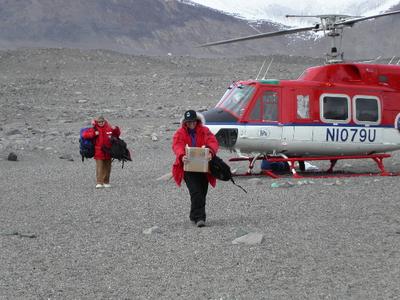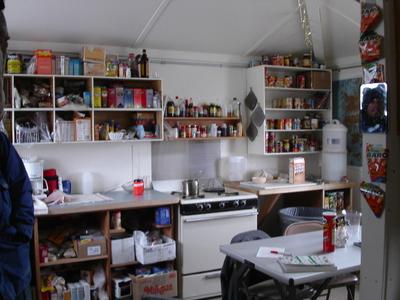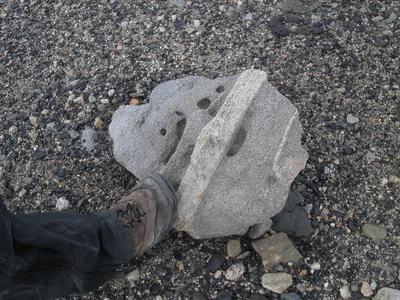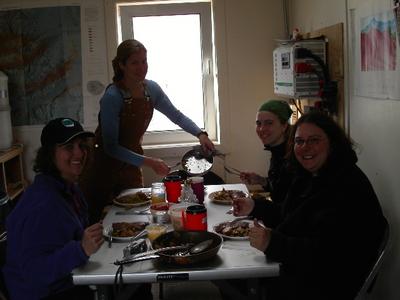6 January, 2003
Coring Problems, So Back To F6
Research is very scientific. This field work as been carefully planned. The total Antarctic experience between Brenda and Chris equals thirty-one research seasons. Yet with all that going for us, things can happen. Late yesterday, the coring team lost the custom made stainless steel coring barrel down a hole. Unable to retrieve it, it is a disappointing set back. We do have another coring device that we can use, but it was meant to be a back up and so to lose this special corer at our first hole was difficult. Chris's plan for the day was to go back to the hole to attempt to fish is out. This did not require a full team of people, so Amber and I set off for F6 again in hopes of arriving early enough to meet up the people camping there, and I was parcticularly hoping to be able to see TEA teacher Louise Huffman.
We took about fifty minutes to walk over because we made many stops along the way to look at the different rocks and to take some photos. Basalt, granites with beautiful pink feldspar, hawaiite, and kenyte can be found everywhere. Kenyte is quite rare and the only other place on earth that you can find it is Kenya, Africa. Kenyte is a volcanic rock, similar to a basalt, and its identifying characteristic is that is has eye shaped crystals of feldspar. We also came upon large ventifacts; rocks that have been shaped by wind and sand. The wind only blows in a few directions on a regular basis so you tend to get faces or patterns on one side of the rock.
We arrived at F6 and again no one was there. We were able to get the converter working so that we had solar power. We tested the power by turning on a CD player that was there. Amber immediately started dancing. I donít think it could be helped. We donít get to hear much music and so it instantly perked us up.
About 15 minutes later, like the opening scene in MASH, we could hear the helicopters coming. Although these camps are for everyoneís use, we still felt a bit awkward strolling into their area. As the helo landed about thirty feet from the small building, Amber and I went out to meet it. I could see Louise waving from the helo. I had my camera with me and shot the photo below. It was great to see her.
Louise, Erin, and Jenny, part of the LTER Stream Team, were kind enough to allow us to spend the day and I was able to write some journal entries and post some photos. We had to do some trouble shooting during the day, as their generator wasnít working and it had clouded over for awhile so we lost solar power. So we called McMurdo, and within three hours, they sent a helo out with a new one for us. I canít imagine getting service like that back home!
At night, the team treated us to a delicious steak dinner. Iím certainly eating better than I thought I would down here.
It was a great day and although we had a long walk back, it was a beautiful, sunny evening. In fact when we got back to the camp, we stopped on a hill near our camp and just stayed for about fifteen minutes to enjoy the evening and to soak up a little sun.

Louise departs helo at F6.

A view of the F6 kitchen area. Much bigger than our cook tent!

Kenyte - universally a rare rock, but rather abundant in the Dry Valleys. It comes from Ross Island and its presence in Taylor Valley is proof that the Ross Ice Shelf once extended this far into the valley.

A ventifact with a vein of quartz running through it.

Louise, Erin, Amber, and Jenny enjoy a steak dinner at F6.

Louise and me in F6.
Contact the TEA in the field at
.
If you cannot connect through your browser, copy the
TEA's e-mail address in the "To:" line of
your favorite e-mail package.
|
